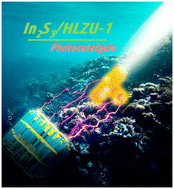Constructing novel hyper-crosslinked In2S3@HLZU-1 through molecular expansion for enhanced photocatalytic performance†
Abstract
A novel hyper-crosslinked In2S3@HLZU-1 heterojunction through molecular expansion was carefully designed and fully characterized. This synthetic strategy not only increased the specific surface area and average pore volume of LZU-1 by 11.3 and 3.6 times, respectively, but also greatly enhanced the photocatalytic performance. Under visible light, the catalyst can degrade 90% of 50 ml, 40 ppm TC solution within 1 h, and the maximum hydrogen evolution rate was 11 920.42 μmol g−1 h−1. SEM, XPS and other characterization techniques proved the existence and the interaction of In2S3 and HLZU-1. The performance of the heterojunction photocatalyst is mainly attributed to: (i) the matching energy band structure between In2S3 and HLZU-1, which ensures the effective separation of photogenerated holes and electrons, and (ii) the hyper-crosslinking treatment, which can improve the photo-absorption and photocatalytic properties of the catalyst. A Z-type photocatalytic mechanism was proposed based on radical trapping experiments and electron spin resonance (ESR) analyses. This study developed an effective molecular expansion strategy to synthesize COF-based catalysts with more catalytic sites for potential applications in the environmental and energy fields.



 Please wait while we load your content...
Please wait while we load your content...